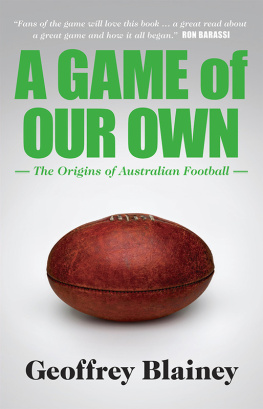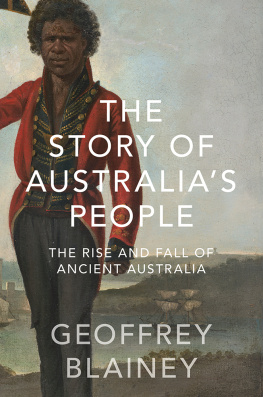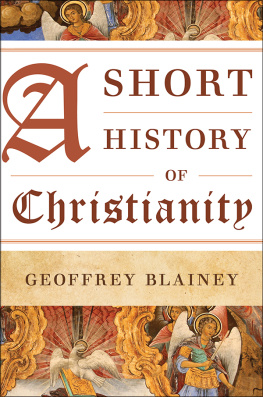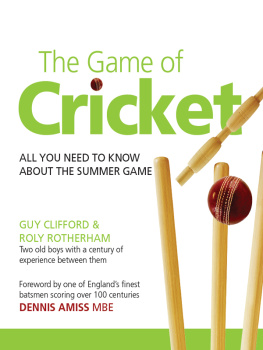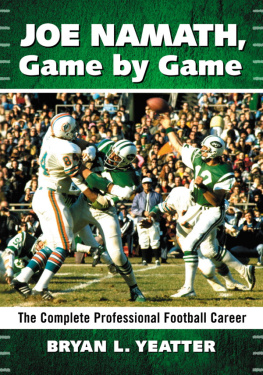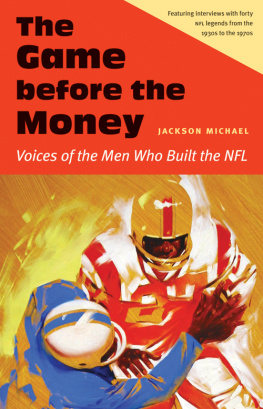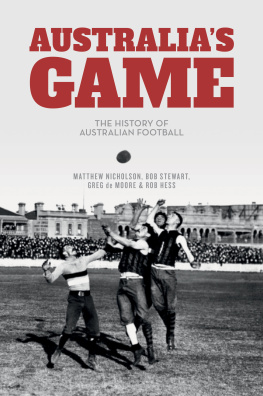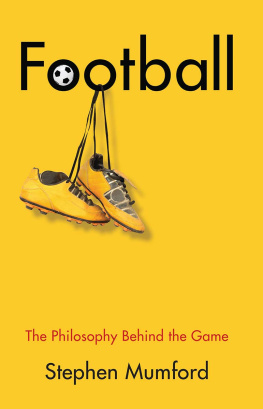Praise for A Game of Our Own
There are too few good footy history books around. So this new edition of Blaineys excellent history of our winter sport is especially welcome. The beauty of Blaineys book is not just his clear writing, but his ability to marry fine detail with broad and thematic sweeps. Its an accessible and diverting picture of how football evolved He has assembled footys causes, origins, problems and solutions into such a coherent and credible whole that everything has a role to play in the evolution of our national game.Herald Sun
Geoffrey Blainey can really write and he has a nose for the forgotten details that make you sit up, such as early games being played on oblong grounds, sides of forty, goals rare and round balls.The Age
A Game of Our Own will bring rich enjoyment to readers with a deep interest in the history of Australian sport and popular culture.JAS Review of Books
ground-breaking, lucidly writtenThe Age
a definitive work on the subjectAustralian Book Review
an enjoyable and informative readThe Mercury
an exhilarating accountAustralian Financial Review
beautifully writtenThe West Australian
A GAME of OUR OWN
The Origins of Australian Football
A GAME of OUR OWN
The Origins of Australian Football
Geoffrey Blainey
Published by Black Inc.,
an imprint of Schwartz Media Pty Ltd
Level 5, 289 Flinders Lane
Melbourne Victoria 3000 Australia
email:
http://www.blackincbooks.com
Copyright Geoffrey Blainey 2010
First edition 1990
Second edition 2003
ALL RIGHTS RESERVED.
No part of this publication may be reproduced, stored in a retrieval system, or transmitted in any form or by any means electronic, mechanical, photocopying, recording or otherwise without the prior consent of the publishers.
Sources of Illustrations: The owners names are followed by the page numbers on which their material appears: A Brace Esq. 200 / Australian Gallery of Sport 43, 80, 205 / John Oxley Library 154 / Mead & Beckett Publishing, S T Gills Australia 34 / Radio Times Hulton Picture Gallery 28 / South Australian Archives 133,136 / State Library of Victoria 6, 23, 39, 65, 72, 76, 83, 86, 89, 93, 95, 102, 111, 127, 140, 147, 149, 158, 191, 202 / T W Cooke collection 4, 69 / Jeff Busby 19 / Ebes collection, Tivoli Cards & Paper 162, 171 / Library Council of Victoria xi.
National Library of Australia Cataloguing-in-Publication entry
Blainey, Geoffrey, 1930
A game of our own : the origins of Australian football
ISBN: 9781863954853 (pbk.)
Previously published: 2003.
Australian football--History.
796.336
Index by Michael Ramsden
Printed in Australia by Griffin Press
Preface
This book traces the origins and the early growth of the game of Australian football, alias Australian Rules. Some of the games early history is lost in the mists of the past, but most of the salient landmarks and changes can be pieced together. Indeed, since the first edition of this book was published in 1990, some of the lost pieces of the jigsaw have come to light through the ransacking of old newspapers and the discovery of forgotten letters, diaries and notebooks. More evidence will be found, and new deductions drawn from that evidence, over the next twenty years.
The game is essentially an Australian invention. It arose in the late 1850s, when the various kinds of English football were still in flux, and at first it borrowed extensively from games played mainly in English public schools and especially at Rugby School. Almost at once it was a distinctive game. So quickly did it move in its own direction under its own momentum, and so often did it devise or adapt rules and tactics that, within twenty years, it was far removed from the older rugby and the new soccer, and was still changing. By the late 1870s, when for the first time a few Melbourne and Adelaide and Sydney clubs made the coastal voyage to play against each other, it had become a very distinctive code of football. The game probably changed even more over the next hundred years. It will continue to change.
ix
On some of the features of the early game, the evidence is sparse. The game had few rules in its first years, and many important matters, such as the shape of the playing field, were not even mentioned. Thus, until the first edition of this book appeared, it was assumed that originally the game must have been played on an oval-shaped playing field. It is easy to see how this idea gained credence because the evidence was meagre. I did not find clues that Australian football was commenced on a rectangular field until nearly a year after I had begun my research I came across a description of a match played between Melbourne and Carlton on 9 June 1877. That day, they were allowed the privilege of playing on the Melbourne Cricket Ground, and the sporting reporter noted their difficulty in adjusting to the wide wings of a circular arena. About the same time I found a diagram of a playing field in the 1877 edition of the annual Victorian magazine The Footballer; the field was oblong. Other clues favour the hypothesis that Australian football began on a rectangular ground and then, when it moved to the various cricket grounds, adapted itself to their round or oval arena.
As it is not easy to investigate a question as elementary as the shape of the early arenas, we cannot be fully confident about several other important facets of the early game. One of the crucial questions is why Australian football did not adopt a sending-off rule. As the arena was huge and as the play sometimes moved with high speed from one end of the arena to the other, it was very difficult for an umpire. There were acts of violence which an umpire could not see: they took place behind the play or were too far ahead of him to be seen clearly. By 1900 violence was all too frequent in Melbourne matches. Other major football codes permitted an umpire or referee to ban an offending player from the field for the remainder of the game, but Australian football refused to adopt that harsh form of discipline. Why it refused is not clear. Only in x recent years has Australian football, at its senior level, adopted a policy of appointing two and now three central umpires. That policy of course leads to inconsistencies, for the game has a cavalcade of rules, some of which depend heavily on personal judgement rather than simple facts.
The first edition of this book ended the story in or around 1880 soon after the forming of the Victorian Football Association, and soon after the playing of the first matches against teams from other colonies. The second edition extended the story for twenty or more years and added new sections to the old while also, here and there, making verbal alterations for the sake of accuracy, clarity or pithiness. Furthermore the early Victorian, South Australian and Gaelic rules printed at the end of the book were augmented by additional rules, as indicators of how the game evolved.
Before and after the first edition of this book appeared, the idea was widespread that Australian football was simply an offshoot of Gaelic football, a rather similar game played in Ireland. Indeed, this book was initially sponsored by the National Australian Football Council and its general manager, Ed Biggs, partly to investigate whether that Gaelic theory was valid. The theory seemed plausible because the two games had much in common. On the other hand, several earlier historians of the Australian game had pointed out that they could find little or no direct evidence in favour of a Gaelic origin. Their conclusions tended to be ignored. Eventually I realised that it was not enough to point to the lack of concrete evidence in favour of the Gaelic interpretation. It was vital to produce evidence positively refuting a Gaelic interpretation. Slowly that evidence came to hand, and it can be found in Chapter 11 of this edition.

